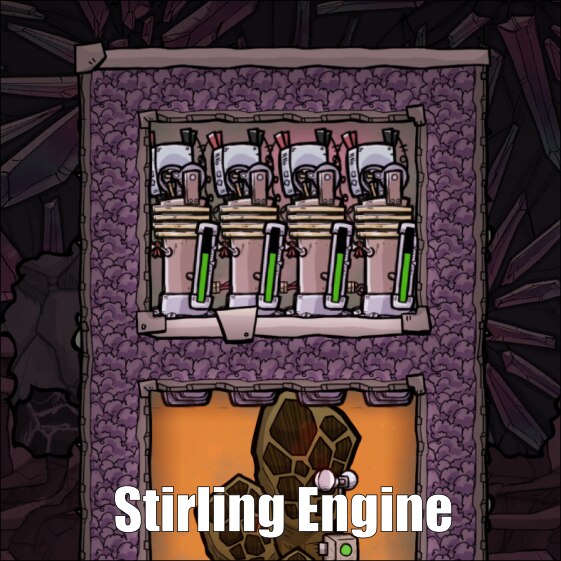Stirling Engine
This mod adds a stirling engine that generates power from heat. It pulls heat from the room below the floor it is placed on and converts part of that heat energy into electrical energy.
Vanilla
Spaced Out
A stirling engine generates power from the compression and expansion of gas using a heat source. The generator must be built on a floor, and will draw heat from the tile below the floor as its heat source. The power generated will be proportional to the temperature gradient between the heat source and the building temperature.
Maximum Power Generated: 100W
Building Materials: 400kg of Metal Ore
Requires the Temperature Modulation research to be built.
The building has a configuration file and provides these values to be tuned:
DTU Per Watt
Determines how much thermal energy is equivalent to one watt.
Default = 100 DTU/W
* There is no "correct" choice because the vanilla game breaks the laws of thermodynamics by choosing a different value for various buildings. For example, the Liquid Tepidizer generates a whopping 4.2 kDTU/W!
Max Power
Determines the maximum power generated by the building at 100% efficiency and proper operating conditons.
Default = 100W
Min. Temperature Difference
Determines the minimum temperature gradient (in kelvin) that the building needs to operate and generate power.
Default = 10K
Waste Heat Ratio
Determines the percentage of heat that is added to the building instead of generating power.
Default = 0.1 (10%)
The building pulls heat out of the heat source tile, converts some of it to energy, and takes some of it into its building temperature.
The most important variable for the machine is the Efficiency value.
Efficiency is determined by the temperature ratio between the heat source tile and the building temperature:
After calculating efficiency, the building pulls an amount of heat from the source tile that is proportional to efficiency.
A greater heat gradient will result in more heat moving.
100% efficiency is theoretical, it would be achieved by making the building temperature reach 0K.
The meter on the building represents the efficiency, not the power generated.
The power generated is related to the Heat Absorbed variable and DTU Per Watt setting.
The value in the tooltip shows the correct amount of power generated.
The value seen in the Energy/Circuit tab is not possible to update in realtime and will always say the max possible generated watts.
Finally, some of the heat that was used for generating power is added to the building using the Waste Heat Ratio setting.
I will ignore requests about changing parameters to rebalance this mod. It is configurable so you can balance it however you like. There is no point in re-uploading the mod just to change those numbers.
This building is based on realistic physics, certain things that seem "unbalanced" or "broken" about this building are in fact realistic and can be observed in experimental conditions. Heat moves faster when the temperature difference is greater. If you have (T_Cold = 1 Kelvin) and (T_Hot = 11K) then the building really is going to let a crazy amount of heat jump from one side to the other because there is a dramatic difference. An 11x gradient like that results in an efficiency of ~91%.
A stirling engine is designed to harvest energy from a heat gradient; It is really going to operate extremely efficiently in edge cases like being near absolute zero. In real life we cannot realistically put an engine in those situations though.
Please keep in mind that ONI is not a very good simulation for thermodynamics in the first place because it is discretizing energy into a grid and also discretizes time passing too. Reality is continuous in terms of space and time and that makes a huge difference in how a system will evolve over time using the same mathematical formulas. It’s like the difference between performing a Riemann sum vs a proper integral in calculus.
Credit goes to CCCanyon for the artwork in this mod.
It is available under the CC BY-SA 3.0 license.
Please post any feedback or issues on my GitHub[github.com]
© 2020 RomenH & CCCanyon


